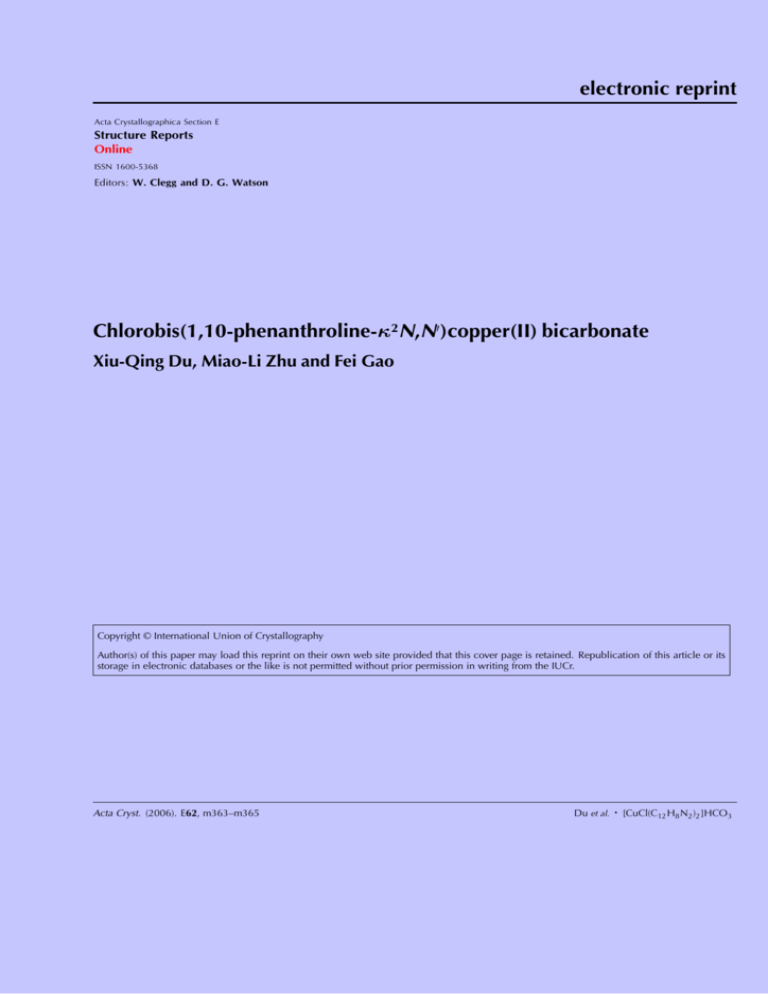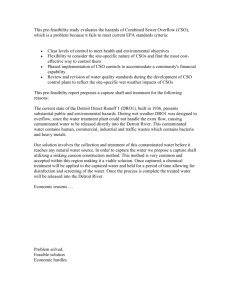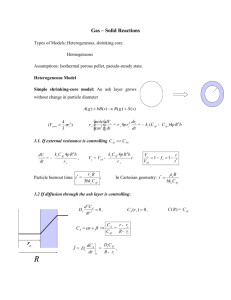
electronic reprint
Acta Crystallographica Section E
Structure Reports
Online
ISSN 1600-5368
Editors: W. Clegg and D. G. Watson
Chlorobis(1,10-phenanthroline-
2
N,N )copper(II) bicarbonate
¼
Xiu-Qing Du, Miao-Li Zhu and Fei Gao
Copyright © International Union of Crystallography
Author(s) of this paper may load this reprint on their own web site provided that this cover page is retained. Republication of this article or its
storage in electronic databases or the like is not permitted without prior permission in writing from the IUCr.
Acta Cryst. (2006). E62, m363–m365
Du et al.
¯
[CuCl(C12 H8 N2 )2 ]HCO3
metal-organic papers
Acta Crystallographica Section E
Structure Reports
Online
Chlorobis(1,10-phenanthroline-j2N,N0 )copper(II)
bicarbonate
ISSN 1600-5368
Correspondence e-mail: feigao@sxu.edu.cn
In the title compound, [CuCl(C12H8N2)2]HCO3, the CuII ion
assumes a trigonal–bipyramidal CuN4Cl coordination
geometry arising from two bidentate 1,10-phenanthroline
(phen) ligands and one chloride ion, with the chloride ion in
an equatorial position. The bicarbonate ion, not included in
the inner coordination sphere, provides charge balance. The
– stacking and weak intermolecular hydrogen-bond interactions link the component units into a three-dimensional
network.
Key indicators
Comment
Xiu-Qing Du, Miao-Li Zhu and
Fei Gao*
Institute of Molecular Science, Key Laboratory of
Chemical Biology and Molecular Engineering of
Ministry of Education, Shanxi University,
Taiyuan, Shanxi 030006, People’s Republic of
China
Single-crystal X-ray study
T = 298 K
Mean (C–C) = 0.007 Å
R factor = 0.065
wR factor = 0.185
Data-to-parameter ratio = 12.6
For details of how these key indicators were
automatically derived from the article, see
http://journals.iucr.org/e.
# 2006 International Union of Crystallography
Printed in Great Britain – all rights reserved
Acta Cryst. (2006). E62, m363–m365
Received 14 December 2005
Accepted 20 January 2006
Online 25 January 2006
Imidazole plays an important role in biological systems, since
the imidazole group of the histidyl residues in a large number
of metalloproteins constitutes all or part of the binding sites of
various transition metal ions (Messerschmidt, 1993). In recent
years, studies aimed at characterizing the bonding between
imidazole and transition metal ions have been of considerable
interest. In particular, binuclear imidazolate-bridged
complexes have attracted much attention as models for
metalloenzymes (Mao et al., 1995; Koch et al., 1989; Colacio et
al., 1998).
Our initial aim was to synthesize imidazolate-bridged
heterobinuclear CuII complexes and study their biological
activities (Patel et al., 2005). To our surprise, we actually
obtained blue crystals of the title compound, (I), without any
coordination of imidazole.
The asymmetric unit of the title compound, (I), contains
one [Cu(phen)2Cl]+ cation and one bicarbonate ion. In the
cation, four N atoms from two bidentate phenanthroline
ligands and one Cl atom form an approximately trigonalbipyramidal arrangement around the Cu2+ ion, with atoms
Cl1, N2 and N4 occupying equatorial positions, while atoms
N1 and N3 are at axial positions (Fig. 1).
doi:10.1107/S1600536806002546
electronic reprint
Du et al.
[CuCl(C12H8N2)2]HCO3
m363
metal-organic papers
Experimental
An alkaline solution of imidazole (34 mg, 0.5 mmol) was added with
stirring to a methanol solution of CuCl22H2O (170 mg, 1.0 mmol). To
this mixture, a methanol solution of 1,10-phenanthroline (396 mg,
2 mmol) was added and stirred for 1 h. A methanol solution of NaBF4
(384 mg, 3.5 mmol) was added to the reaction mixture and stirred for
a further 1 h. The resulting light-green precipitate was filtered and
dissolved in CH3OH/CH3CN (1:1) for recrystallization. The solution
was kept at room temperature and light-blue crystals were formed
after a week (yield 0.17 g, 32%).
Crystal data
Figure 1
The asymmetric unit of the title compound with the atom-numbering
scheme. Displacement ellipsoids are drawn at the 25% probability level.
Dx = 1.527 Mg m3
Mo K radiation
Cell parameters from 4047
reflections
= 2.5–25.5
= 1.12 mm1
T = 298 (2) K
Block, blue
0.40 0.35 0.18 mm
[CuCl(C12H8N2)2]HCO3
Mr = 520.42
Monoclinic, P21 =c
a = 12.4833 (19) Å
b = 11.3559 (17) Å
c = 17.112 (3) Å
= 111.075 (2)
V = 2263.5 (6) Å3
Z=4
Data collection
3885 independent reflections
3266 reflections with I > 2(I)
Rint = 0.023
max = 25.0
h = 14 ! 14
k = 13 ! 13
l = 20 ! 13
Bruker SMART 1K CCD areadetector diffractometer
’ and ! scans
Absorption correction: multi-scan
(SADABS; Sheldrick, 1996)
Tmin = 0.663, Tmax = 0.824
8919 measured reflections
Refinement
Refinement on F 2
R[F 2 > 2(F 2)] = 0.065
wR(F 2) = 0.185
S = 1.05
3885 reflections
308 parameters
H-atom parameters constrained
w = 1/[ 2(Fo2) + (0.1246P)2
+ 1.1895P]
where P = (Fo2 + 2Fc2)/3
(/)max < 0.001
max = 0.94 e Å3
min = 0.74 e Å3
Table 1
Selected geometric parameters (Å, ).
Figure 2
Packing diagram, viewed approximately down the a axis (large green
spheres for Cl atoms, small green spheres for H atoms and red spheres for
O atoms; dotted lines for – stacking and dashed lines for hydrogen
bonds).
The bond angles in the equatorial plane (Table 1) are
distorted from the ideal trigonal value (120 ), with two smaller
angles and one larger angle [N4—Cu1—Cl1 = 126.75 (10) ].
As illustrated in Fig. 2, the packing is dominated by –
stacking and weak intermolecular hydrogen-bond interactions. The face-to-face distance between parallel phen rings
of neighboring cations is 3.687 (3) Å. There are two kinds of
hydrogen bonds (C—H O and C—H Cl), formed between
a carboxylate O atom and a CH group from a phen ring, and
between the Cl atom and a CH group in a phen ring from
another complex unit, respectively (Table 2).
m364
Du et al.
[CuCl(C12H8N2)2]HCO3
Cu1—N3
Cu1—N1
Cu1—N4
1.983 (3)
1.988 (3)
2.071 (3)
Cu1—N2
Cu1—Cl1
2.114 (3)
2.2914 (13)
N3—Cu1—N1
N3—Cu1—N4
N1—Cu1—N4
N3—Cu1—N2
N1—Cu1—N2
175.79
81.42
97.75
95.76
80.77
N4—Cu1—N2
N3—Cu1—Cl1
N1—Cu1—Cl1
N4—Cu1—Cl1
N2—Cu1—Cl1
113.89
92.63
91.16
126.75
119.36
(15)
(13)
(14)
(15)
(14)
(13)
(12)
(10)
(10)
(10)
Table 2
Hydrogen-bond geometry (Å, ).
D—H A
C23—H23 Cl1
C20—H20 Cl1ii
C15—H15 O1
C14—H14 Cl1iii
C7—H7 O2iv
i
D—H
H A
D A
D—H A
0.93
0.93
0.93
0.93
0.93
2.65
2.76
2.38
2.76
2.59
3.557
3.620
3.247
3.668
3.333
166
154
155
165
138
(4)
(5)
(7)
(5)
(8)
Symmetry codes: (i) x; y 12; z þ 12; (ii) x; y þ 12; z 12; (iii) x þ 1; y þ 1; z þ 1;
(iv) x 1; y þ 12; z þ 12.
electronic reprint
Acta Cryst. (2006). E62, m363–m365
metal-organic papers
H atoms were positioned geometrically [0.82 (OH) and 0.93 Å
(CH)] and constrained to ride on their parent atoms with Uiso(H)
values of 1.2 (1.5 for OH) times Ueq(C,O).
Data collection: SMART (Bruker, 2000); cell refinement: SAINT
(Bruker, 2000); data reduction: SAINT; program(s) used to solve
structure: SHELXS97 (Sheldrick, 1997); program(s) used to refine
structure: SHELXL97 (Sheldrick, 1997); molecular graphics:
SHELXTL/PC (Sheldrick, 1999); software used to prepare material
for publication: SHELXTL/PC.
The authors thank Xiao-Hua Pu for helpful suggestions.
This work is financially supported by the National Natural
Science Foundation of China (grant No. 20471033 for ML
Zhu) and the Provincial Natural Science Foundation of Shanxi
(for FG).
Acta Cryst. (2006). E62, m363–m365
References
Bruker (2000). SMART (Version 5.0) and SAINT (Version 6.02). Bruker AXS
Inc., Madison, Wisconsin, USA.
Colacio, E., Dominguez-Vera, J. M., Ghazi, M., Kivekäs, R., Klinga, M. &
Moreno, J. M. (1998). Inorg. Chem. 37, 3040–3045.
Koch, C. A., Reed, C. A., Brewer, G. A., Rath, N. P., Scheidt, W. R., Gupta, G.
& Lang G. (1989). J. Am. Chem. Soc. 111, 7645–7648.
Mao, Z. W., Chen, M.-Q., Tan, X.-S., Liu, J. & Tang, W.-X. (1995). Inorg. Chem.
34, 2889–2893.
Messerschmidt, A. (1993). Adv. Inorg. Chem. 40, 121–185.
Patel, R. N., Singh, N., Shukla, K. K., Gundla, V. L. N. & Chauhan, U. K.
(2005). J. Inorg. Biochem. 99, 651–663.
Sheldrick, G. M. (1996). SADABS. University of Göttingen, Germany.
Sheldrick, G. M. (1997). SHELXS97 and SHELXL97. University of
Göttingen, Germany.
Sheldrick, G. M. (1999). SHELXTL/PC. Version 6.10. Bruker AXS Inc.,
Madison, Wisconsin, USA.
electronic reprint
Du et al.
[CuCl(C12H8N2)2]HCO3
m365




